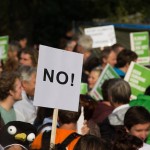Post 8 – How Good Do We Have to Be?
I wonder and I wonder and I wonder. I stand looking out towards the future and I wonder. I want to know and I want to understand.
The title of this post is the name of a book I read some years ago which was unrelated to climate change but I liked the title and I liked the question. I am borrowing it for this post because it expresses one of the key questions I have about the effects of global warming and its impact on my life. As I have said before, my goal is to live a lifestyle that would not, if everyone chose to live similarly, destroy our planet but how do I know when I have achieved that goal? I think I am prepared to do what is necessary but, to be honest, I don’t want to do more than I have to. I like my lifestyle; I would prefer that it didn’t have to change but I know it has to and probably far more than it has to date. I believe I am moving step by step towards living a low carbon life but when have I traveled far enough? I have looked at various carbon footprint and emission calculators but they are not adequate. Generally, they don’t tell me when I have reached a satisfactory personal or household target and nor do they provide the motivation of showing, the hopefully positive effects, of my incremental improvements.
I regularly look for material that helps me to understand how I should be living and what lifestyle changes I should be making. For example, if I choose to buy a tube of gorgeous imported hand  cream, that will have been freighted a long way from Europe, can I offset that by not using a highly powered hair dryer. These are probably not the best examples with which to make my point, they’re probably even clichéd, but they are real and I’m sure you get the drift. I ask what is my carbon budget? How many emissions can I generate as a result of my lifestyle? I’ve read articles that suggest we all might end up with, horror of horrors, a carbon budget and that would be really terrible, without disclosing why it would be terrible. I think it could be a good thing. If it was sufficiently comprehensive, then it could answer my questions about personal and household lifestyles. Having said that, dare I say that a price on carbon, or more particularly, a price on carbon dioxide equivalent (CO2-e) emissions could also answer the questions I am posing. In effect it would be a type of carbon budget with price as a proxy measure. Prices would rise on items that caused high carbon dioxide equivalent emissions and we could choose, or not, to purchase those items. Certainly, this would be the case at the level of discretionary expenditure. Those items that emitted a lot of green house gases, in either their manufacture or use, may become unaffordable but so be it. As far as those items that are considered essential are concerned, which would include energy such as electricity, then appropriate adjustments would need to be made at the level of government for those who were negatively impacted by the changes. We would make choices and our lives would change b
cream, that will have been freighted a long way from Europe, can I offset that by not using a highly powered hair dryer. These are probably not the best examples with which to make my point, they’re probably even clichéd, but they are real and I’m sure you get the drift. I ask what is my carbon budget? How many emissions can I generate as a result of my lifestyle? I’ve read articles that suggest we all might end up with, horror of horrors, a carbon budget and that would be really terrible, without disclosing why it would be terrible. I think it could be a good thing. If it was sufficiently comprehensive, then it could answer my questions about personal and household lifestyles. Having said that, dare I say that a price on carbon, or more particularly, a price on carbon dioxide equivalent (CO2-e) emissions could also answer the questions I am posing. In effect it would be a type of carbon budget with price as a proxy measure. Prices would rise on items that caused high carbon dioxide equivalent emissions and we could choose, or not, to purchase those items. Certainly, this would be the case at the level of discretionary expenditure. Those items that emitted a lot of green house gases, in either their manufacture or use, may become unaffordable but so be it. As far as those items that are considered essential are concerned, which would include energy such as electricity, then appropriate adjustments would need to be made at the level of government for those who were negatively impacted by the changes. We would make choices and our lives would change b ut, if we were smart enough about how we structured our arrangements, then we might enjoy the prospect of the future rather than fearing it. To date, this idea typically becomes manifest in one of two ways, a carbon tax or an emissions trading scheme. As I draw this paragraph to an end, I wonder if I will look back on it and cringe with embarrassment at its naivety but, whatever the case, it is a genuine reflection of questions and possibilities that I am currently thinking about.
ut, if we were smart enough about how we structured our arrangements, then we might enjoy the prospect of the future rather than fearing it. To date, this idea typically becomes manifest in one of two ways, a carbon tax or an emissions trading scheme. As I draw this paragraph to an end, I wonder if I will look back on it and cringe with embarrassment at its naivety but, whatever the case, it is a genuine reflection of questions and possibilities that I am currently thinking about.
In my search for helpful material about how to live a low carbon life, I read many articles about sustainable practices including replacing incandescent light globes with compact fluorescent lamps (CFLs) or light emitting diodes (LEDs). For some reason, this particular practice often seems to be derided as an example of what is not enough, and too low-level, when big, big, big changes need to be made at the political level. The usual implication is that our energies should go into the big changes rather than dealing with light globes. Certainly, I agree with the principle that when we have scarce resources, in this case our time, we should apply those resources in a way that maximizes the outcomes but, for many people, change starts and ends with the personal and the domestic and any political action is confined to election day choices. A lot of electricity continues to be wasted with incandescent light bulbs so go ahead and change those bulbs and congratulate yourself on a good job. I will share my experiences of converting our house to low energy lighting in an other post (parked). As far as election day choices and decisions are concerned, that is personal but it is a right that shouldn’t be taken for granted and so I suggest it merits fresh consideration each and every time, but more so in this time of impending change.
other post (parked). As far as election day choices and decisions are concerned, that is personal but it is a right that shouldn’t be taken for granted and so I suggest it merits fresh consideration each and every time, but more so in this time of impending change.
As much as we are often challenged to act politically in relation to global warming, we also need to live our beliefs. I find it difficult to take anyone seriously who says one thing and does another. I would like to see those who emerge as leaders on this matter, showing us how to live a low carbon life and caring what it means to us, personally and domestically, as we make the necessary changes to our lives. On a fun note, the ever resourceful HC sent me a review of a book called ‘How Bad Are Bananas? The Carbon Foot-printing of Everything‘. I have ordered a digital version of the book, even though I would prefer a hard copy version, as I really, really, try to live a congruent life. The book sounds absolutely consistent with my interests and this blog so I’ll undertake to see if I can find out the carbon footprint of my hand  cream, hair dryer, light bulbs and, of course, bananas themselves. Bye for now, Jane
cream, hair dryer, light bulbs and, of course, bananas themselves. Bye for now, Jane

